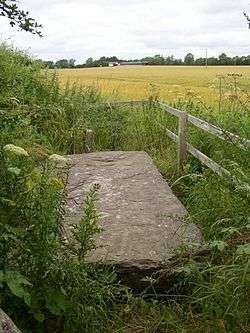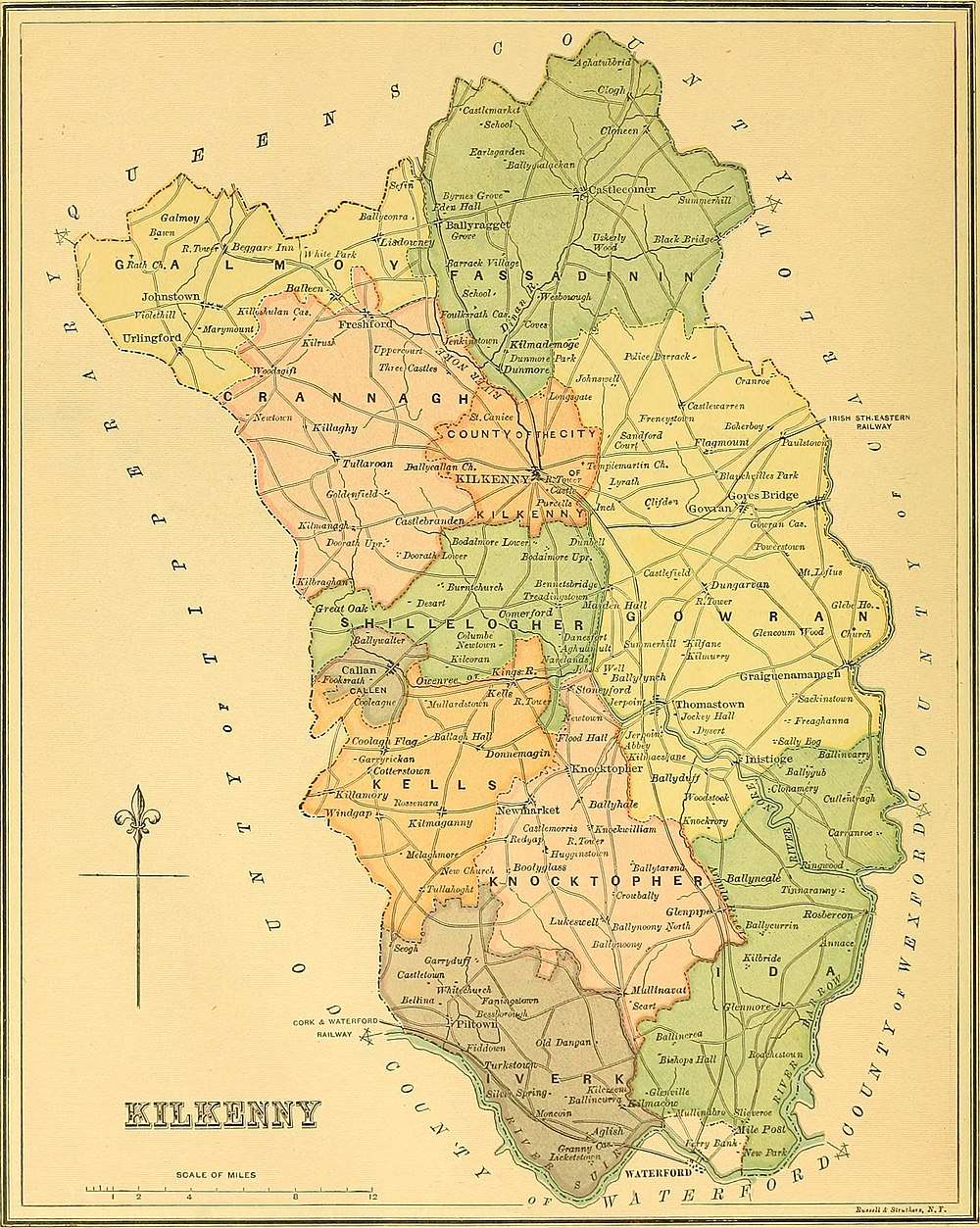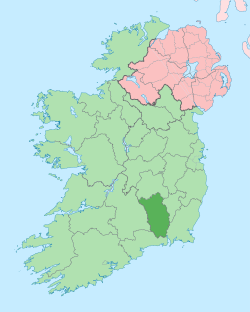Knocktopher (barony)
The barony of Knocktopher (Irish: Cnoc an Tóchair, meaning "'Hill of the Causeway'") is a barony in the west of County Kilkenny, Ireland.[1][3][7] The barony is 46,765 acres (189.25 km2) in size. There are 16 civil parishes made up of 125 townlands.[1] It is one of 12 baronies in the county.[8] The chief town is Mullinavat and it contains the settlements of Stonyford, Ballyhale, Hugginstown, Knocktopher, and Dunnamaggan.[9] The M9 motorway bisects the barony.
Barony of Knocktopher[1] | |
|---|---|
 Ballyboodan Ogham Stone inscribed "Here lies Corbmac ó Cuinn". | |
| Etymology: Hill of the Causeway[3] | |
Barony of Knocktopher | |
 Barony of Knocktopher[1] Location in Ireland | |
| Coordinates: 52°26′2.66″N 7°11′39.25″W[4] | |
| Country | Ireland |
| Province | Leinster |
| County | County Kilkenny |
| Civil parishes | List
|
| Government | |
| • Type | County Council |
| • Body | Kilkenny County Council |
| Area | |
| • Total | 22.9 km2 (8.8 sq mi) |
Knocktopher lies at the west of the county, the barony is bordered by Kells to the west (whose chief town is Kells), by the baronies of Shillelogher and Gowran to the north (whose chief towns are Bennettsbridge and Gowran), and the baronies of Iverk and Ida and to the south (whose chief towns are Slieverue and Piltown).
The rivers Black Water, King's River, Little Arrigle, and Arrigle River flow through the barony.[10] The Walsh Mountains make up a large part of the barony.[3][11] Other historic sites include Norelands House, Saint Molings Well, and Goat's Bridge.[12][13][14]
Knocktopher was an early medieval cantred within the shire of Kilkenny,[15] and part of the historic kingdom of Osraige (Ossory).[16] Today it is part of the Roman Catholic Church diocese of Ossory and the Church of Ireland diocese of Cashel and Ossory. Knocktopher is currently administered by Kilkenny County Council.[5]
History
Originally part of the historic kingdom of Osraige (Ossory).[16] In the latter 12th century, at the time of the Cambro-Norman invasion, MacBraoin (MacBreen) were the main Gaelic sept in the Knocktopher area.[16][15]
Over the Clanns I commemorate,
A fine district of beauteous nuts;
O'Broithe over free Magh Sedna."
O'Donovan believed that the Clanna or Clanns, were seated in the barony of Knocktopher but were supplanted by the Breathnach or Bhreathnach (or Walshes meaning Welshman), who held land there after the Norman Invasion of Ireland.[3] The Norman family of Wall was based there.[15]
The 1st Baron (feoffee) of Knocktopher was probably Griffin FitzWilliam, a Cambro-Norman knight from Wales, a son of William FitzGerald de Carew, Lord of Carew (of Carew Castle, Pembroke, Wales). Griffin Fitz-William was given the cantred [barony] of Knocktopher.[15] Griffin and his brother Raymond le Gros took part in the conquest of Ireland. They were the grandsons of Arnulf de Montgomery and Princess Nest ferch Rhys, daughter of Rhys ap Tewdwr the last independent Prince of South Wales.[18]
The "Barony of Cnoktofre" was first mentioned in the year 1358.[3] Knocktopher was recorded in the Down Survey (1656),[19], the 1840 Ordnance Survey Map[20] and on Griffith's Valuation (1864).[21] It was established by 1672 and depicted in Hiberniae Delineatio, "Perry's Atlas",[22] engraved in 1671-2 by William Petty from the data of the Down Survey.[23]
Geography

Knocktopher contains the civil parishes Aghaviller, Killahy, Kilbeacon, Kilkeasy, Knocktopher, Derrynahinch, Dunnamaggan, Fiddown, Ennisnag, Listerlin, Lismateige, Muckalee, Rossinan, Jerpointwest, Stonecarthy, and Jerpointchurch.[24] The barony contains St. Peter's Church in Ennisnag, the previous location of the Monastery of Inisnag.
Parts of the barony were in the Poor law unions of Carrick on Suir, New Ross, Thomastown, and Waterford.[25]
See also
- Barony (county division)
- Barony (Ireland)
- List of baronies of Ireland
- List of townlands of County Kilkenny
- List of Irish Local Government Areas 1900 - 1921
References
Footnotes
- (Fiontar 2008, Cnoc an Tóchair/Knocktopher)
- (Government 2003)
- (Carrigan 1905, p. 26, Existing Civil Divisions or Baronies)
- "Barony of Knocktopher, Co. Kilkenny". townlands.ie.
- (Kilkenny County County. "Website". kilkennycoco.ie.)
- ("Barony of Callan, Co. Kilkenny". townlands.ie.)
- (Tighe 1802, p. 4, Baronies)
- (Fiontar 2008, County Kilkenny Baronies)
- (Fiontar 2008, Knocktopher) and (Fiontar 2008, Knocktopher population centre)
- (Fiontar 2008, Knocktopher Rivers)
- (Fiontar 2008, Walsh Mountains)
- (Fiontar 2008, Norelands House)
- (Fiontar 2008, Saint Molings Well)
- (Fiontar 2008, Goat's Bridge)
- Walsh, Dennis. "The Baronies of Ireland". ancestry.com., Walsh, Dennis. "Barony Map of the Leinster Region". ancestry.com., and Walsh, Dennis. "Barony of Knocktopher". ancestry.com.
- (O'Huidhrin 1851, p. 8-9, PDF)
- (O'Huidhrin 1851, p. 8, PDF)
- See. Orpen, Vol 1, pp 181-182.
- Down Survey Project. "Knocktopher Map". downsurvey.tcd.ie. The Down Survey Project.
- 1840 Ordnance Survey (OSI 2016, Maps – 27, 28, 31, 32, 35, 36, 39, 40, 43)
- (Griffith 1864, Knocktopher Search)
- Petty, Sir William (1685). Hiberniae Delineatio: Atlas of Ireland. Frank Graham. ISBN 9780900409301.
- Down Survey Project. "County Kilkenny Map". downsurvey.tcd.ie.
- (Fiontar 2008, Knocktopher Civil Parishes)
- (Parliament 1862, p. 976, Knocktopher Barony)
Sources
- Carrigan, William (1905). The History and Antiquities of the Diocese of Ossory. Middle Abbey Street, Dublin: Sealy, Bryers & Walker. ISBN 9785879206463.CS1 maint: ref=harv (link)
- Fiontar (2008). "Placenames Database of Ireland". logainm.ie. Department of Arts, Heritage, Regional Rural and Gaeltacht Affairs of the Government of Ireland.CS1 maint: ref=harv (link)
- Griffith, Richard John (1864). "Griffith's Valuation". www.askaboutireland.ie.CS1 maint: ref=harv (link)
- Government (1836). Grand Jury (Ireland) Act, 1836. Dublin: Government of Ireland.
- Government (2003). Placenames (Co. Kilkenny) Order 2003 (PDF). Dublin: Government of Ireland.CS1 maint: ref=harv (link)
- O'Huidhrin, Giolla Na Naomh (1851). O'Donovan, John (ed.). The tribes and territories of ancient Ossory; comprising the portions of O'Heerin's and O'Dugan's topographical poems which relate to the families of that district. Dublin: J. O'Daly. ISBN 978-1143947490.CS1 maint: ref=harv (link)
- OSI, Ordnance Survey Ireland (2016). "Ordnance Survey". osi.ie.CS1 maint: ref=harv (link)
- Parliament (1862). General alphabetical index to townlands and towns, parishes and baronies of Ireland.CS1 maint: ref=harv (link)
- Tighe, William (1802). Statistical observations relative to the county of Kilkenny: made in the years 1800 & 1801. Printed by Graisberry and Campbell.CS1 maint: ref=harv (link)
External links
- Walsh, Dennis. "Barony of Knocktopher". ancestry.com.
- Fiontar. "Barony of Knocktopher". logainm.ie.
- "Barony of Knocktopher". townlands.ie.


